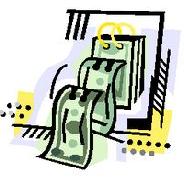
 |
|
| Financial Terms | |
| Economic exposure |
|
Information about financial, finance, business, accounting, payroll, inventory, investment, money, inventory control, stock trading, financial advisor, tax advisor, credit.
Main Page: payroll, accounting, stock trading, credit, tax advisor, money, business, inventory control, |
Definition of Economic exposure
Economic exposureThe extent to which the value of the firm will change because of an exchange rate change.
Related Terms:economic components modelAbrams’ model for calculating DLOM based on the interaction of discounts from four economic components. Accounting exposureThe change in the value of a firm's foreign currency denominated accounts due to a Balance sheet exposureSee:accounting exposure. Economic assumptionseconomic environment in which the firm expects to reside over the life of the Economic defeasanceSee: in-substance defeasance. Economic dependenceExists when the costs and/or revenues of one project depend on those of another. Economic earningsThe real flow of cash that a firm could pay out forever in the absence of any change in  Economic incomeCash flow plus change in present value. Economic order quantity (EOQ)The order quantity that minimizes total inventory costs. Economic rentsProfits in excess of the competitive level. Economic riskIn project financing, the risk that the project's output will not be salable at a price that will Economic surplusFor any entity, the difference between the market value of all its assets and the market Economic unionAn agreement between two or more countries that allows the free movement of capital, Exposure nettingOffsetting exposures in one currency with exposures in the same or another currency, Leading economic indicatorseconomic series that tend to rise or fall in advance of the rest of the economy. Operating exposureDegree to which exchange rate changes, in combination with price changes, will alter a Transaction exposureRisk to a firm with known future cash flows in a foreign currency that arises from Translation exposureRisk of adverse effects on a firm's financial statements that may arise from changes in exchange rates. Economic Value Added (EVA)Operating profit, adjusted to remove distortions caused by certain accounting rules, less a charge economic integrationthe creation of multi-country markets economic order quantity (EOQ)an estimate of the number economic production run (EPR)an estimate of the number economically reworkedwhen the incremental revenue from the sale of reworked defective units is greater than economic value added (EVA)a measure of the extent to which income exceeds the dollar cost of capital; calculated Economic lifeThe period over which a company expects to be able to use an asset. economic order quantityOrder size that minimizes total inventory costs. economic value added (EVA)Term used by the consulting firm Stern Stewart for profit remaining after deduction of the cost Classical MacroeconomicsThe school of macroeconomic thought prior to the rise of Keynesianism. EconomicsThe study of the allocation and distribution of scare resources among competing wants. MacroeconomicsThe study of the determination of economic aggregates such as total output and the price level. MicroeconomicsThe study of firm and individual decisions insofar as they affect the allocation and distribution of goods and services. Supply-Side EconomicsView that incentives to work, save, and invest play an important role in determining economic activity by affecting the supply side of the economy. Related to : financial, finance, business, accounting, payroll, inventory, investment, money, inventory control, stock trading, financial advisor, tax advisor, credit. |